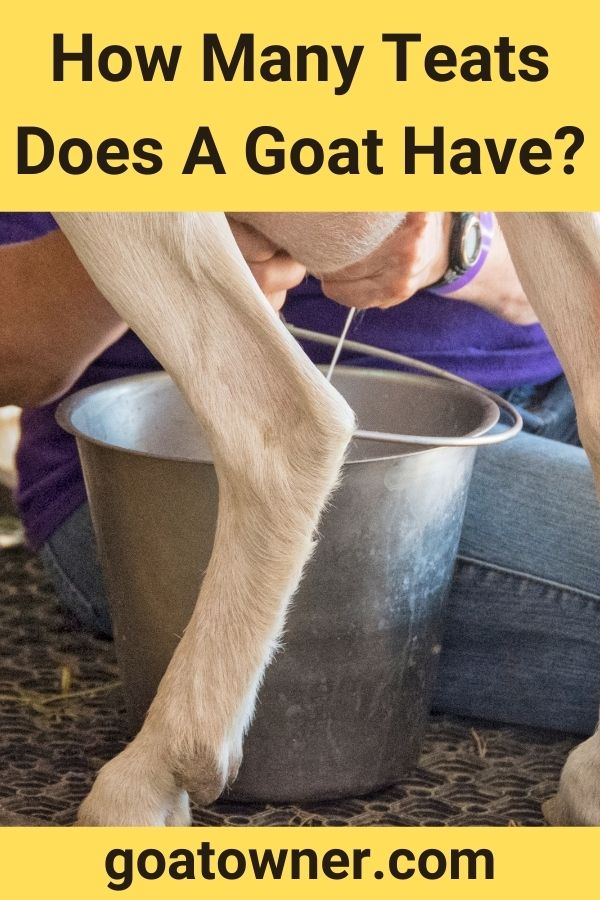I went to a restaurant with my husband, where we ordered a cheese board with a wide variety of cheeses.
His favorite was the goat cheese, which got him wondering about how goat cheese was made.
He was familiar with the milking process for cows, but he didn’t know what it was like for goats.
To understand this better, I had to begin with an important question:
How many teats does a goat have?
Goats, like sheep, horses, and guinea pigs, have only two teats. This puts them on the low end of the spectrum, as other primates have anywhere from four to eighteen teats. Interestingly, although both goats and cows produce milk, cows have two more teats than goats.
So now that you know how many teats a goat has, let’s dive into some further questions.
What is a teat?
A teat is a protrusion from a female mammal’s mammary gland, which produces milk.
Milk is suckled from the mother by her young through the teat.
The teat can also be milked by a human or machine, which extracts milk for human consumption.
What is the difference between a teat and an udder?
An udder is the sack-like part of the milk-giving animal, which creates milk, while the teat is the protrusion from which the offspring suckles.
The teat is attached to the udder.
Udders come in all shapes and sizes, and it’s important for the animal to have healthy utters.
In goats, the utter should not be sagging away from the body.
Instead, it should remain high and close to the underside of the animal.
Why don’t you want a low-hanging udder?
The answer is because it will not last for multiple years of milking.
Low-hanging udders are at a particularly high risk of damage.
What are some of the variations in teats?
Teats come in all sizes.
Sometimes they are large and sometimes they are small.
They are not necessarily symmetrical.
However, some official breeds have guidelines for appropriate teats in their breeds.
For example, the pygmy goat regulations say, “Teats – cylindrical, of uniform length and size – sufficient for milking with two fingers and thumb; symmetrically placed; free of obstruction, deformities or multiple orifices.”
This organization considers teats that are too small, too close together, or too uneven to be faulty.
Still, many goats without such an illustrious heritage find themselves with variation in their teats, which often function just fine.
Why does orifice size matter on a teat?
Orifices refer to the openings on the teat where the milk comes out.
It is important that the orifice is sufficiently large or else it will take a very long time for the milk to come out.
This can limit the feeding capacities for a kid (a baby goat) or waste a lot of time for the human who is milking the goat.
It is worth noting that teats can grow over time, but orifices cannot.
Orifices are usually determined by genetics, so if the mother has large orifices, then her daughter will likely have them too.
However, this is not always the case.
Note: if you are considering buying a doe for her milk supply, it is worth doing a “test milking” first before purchasing her in order to ensure that her orifices are sufficiently large enough to make milking easy.
Is it possible for a goat to have extra teats?
Yes, it is possible for a goat to have extra teats.
These extra teats are called “supernumerary” teats.
In goats that are raised for meat, having extra teats isn’t a major issue.
In fact, people hardly care.
However, this is not the case for dairy goats, in which extra teats are considered a major flaw.
Many farmers claim they wouldn’t sell a doe or buck with such a deformity, and they recommend that others shouldn’t purchase them.
So, what’s the problem with extra teats?
Well, the extras probably don’t produce milk.
So, the kid could look like they’re nursing on one of the teats, but not actually receive any milk, which could have disastrous consequences for their health.
Do baby goats develop a preference for one teat over another?
Yes, it is common for baby goats to develop a preference for one teat over another.
This happens because one side might initially be easier for them to suckle.
As a result, they keep going back to that side.
However, this is a problem because the other side becomes more and more full, which is uncomfortable for the mother.
A responsible farmer should milk the other side to relieve the doe’s discomfort, even though it’s not necessary to milk the other side completely.
What are some of the diseases that can affect teats?
Just like in other nursing mammals (including humans, sheep, and pigs) goats’ udders and teats are prone to inflammation, which is called mastitis.
Mastitis is caused by injury, stress, and bacteria, and can be treated with antibiotics.
An udder affected by mastitis will become swollen, hot, and tender.
Mastitis also decreases the milk supply.
Besides antibiotics, a more natural treatment to mastitis involves mixing a few drops of tea tree oil with a carrier oil, like olive oil or coconut oil, and applying it to the udder area.
Does nursing ruin a goat’s teats or udders?
It is a myth that letting a doe nurse her young ruins her teats or udders.
Some farmers might use this flawed idea as rationale for pulling kids from their mothers early.
However, goats, like all mammals, have evolved to nurse their young, so allowing this natural process to unfold has no negative impact on the doe whatsoever.
Many farmers report no difference in the udders between does that have nursed two kids versus does that have nursed six.

